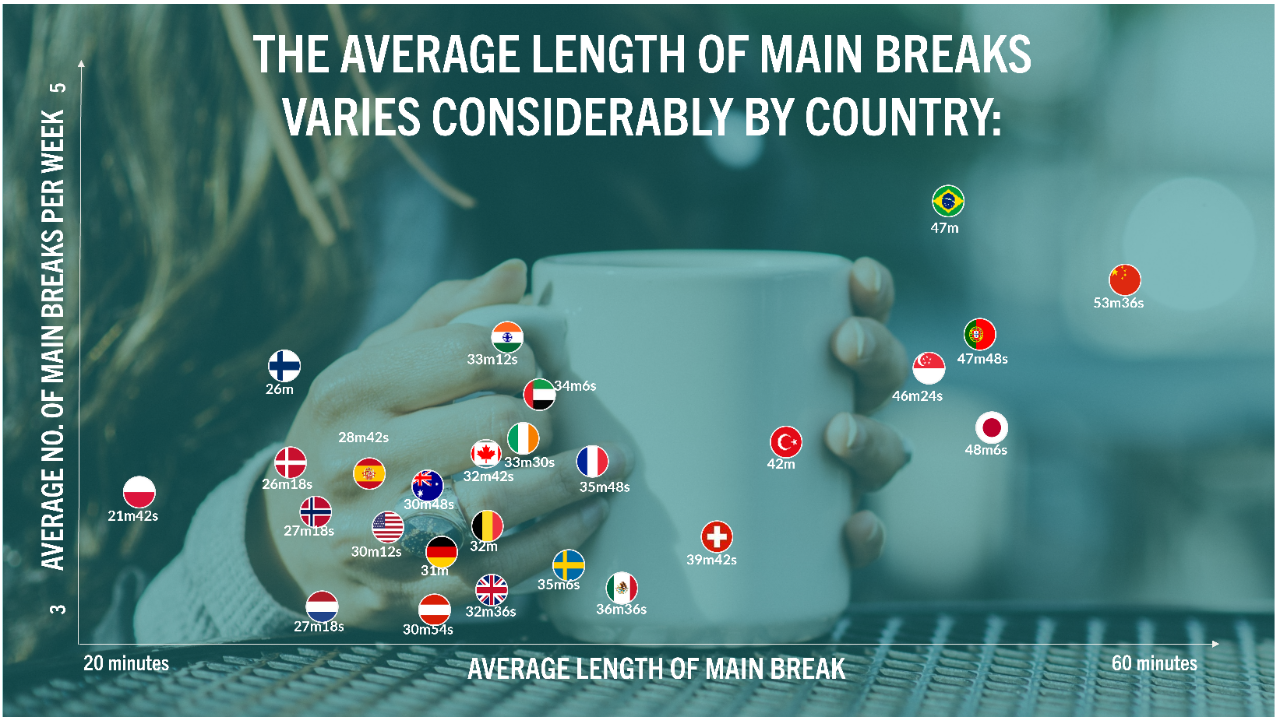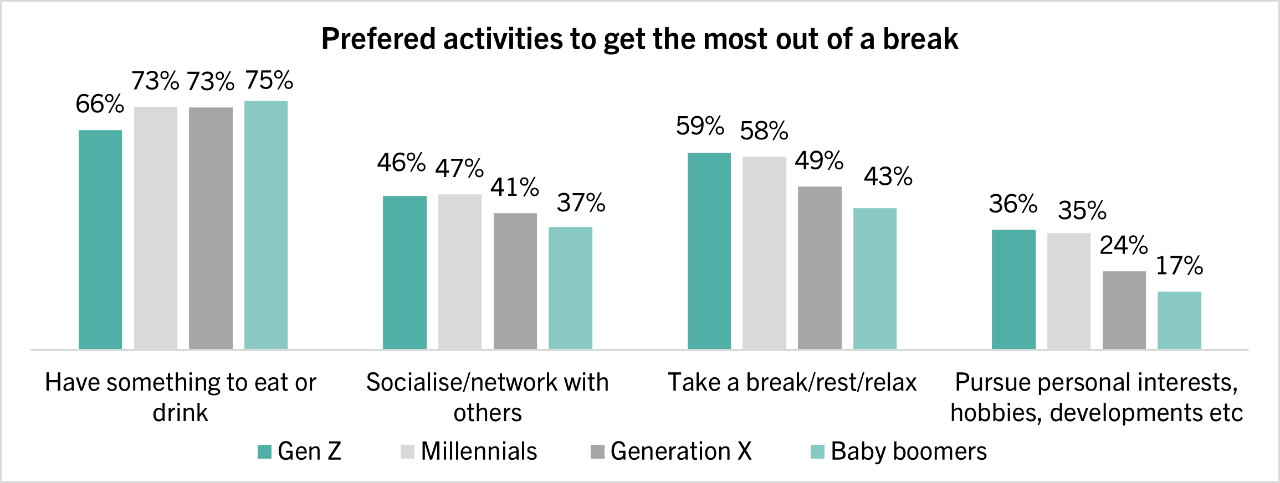©BBC 2023, All rights reserved. Used with permission.
NEW RESEARCH SHOWS THAT BETTER, MORE RESTORATIVE BREAKS AT WORK MAKE FOR HAPPIER, MORE PRODUCTIVE EMPLOYEES
- New research finds lunch breaks now average just 35 minutes per day, with a third of workers eating lunch alone
- 8 in 10 workers think employers should provide quality breakout areas at work for them to relax and recharge
- Workers are significantly more likely to network with colleagues if food and drink facilities are provided at work
- Gen Z most likely to spend breaks on activities that benefit their mental health, including socialising with colleagues
Employers that encourage their teams to take longer, better quality and more frequent breaks could hold the key to unlocking productivity, improving employee wellbeing, and enticing more people back to work, reveals new research from Compass Group, the world's leading food services company, and global market intelligence agency Mintel.
Analysing insights from 35,000 workers across 26 countries, Compass Group’s Global Eating at Work Survey 2023 found that the length of time workers spend on their main lunch break varies considerably as you look around the world, from 54 minutes in China - one of the world’s fastest growing economies - to a little over 20 minutes in Poland.

The research reveals that workers today are taking just 35 minutes per day for their main lunch break, if they have one at all, reducing opportunities to rest, recharge and socialise with colleagues.
- Employees working five days a week were found to skip one lunch break per week, while a third of workers eat their lunch alone.
- At risk of burnout, 7% of workplace-based employees report taking no breaks at all during their working week versus just 3% of hybrid and home-based workers.
Employers who invest in quality breakout areas and food and drink offerings can positively influence the productivity and wellbeing of their workforce.
- 78% of workers globally said that taking a lunch break makes them more productive.
- 85% of workers said that taking regular breaks throughout a workday improves their overall productivity, with more than 7 in 10 employees using these breaks to eat and drink.
- In support of employee wellbeing, 8 in 10 workers think it’s important that employers provide a place at work where they can take a proper break to relax and recharge.
Across all age groups, different generations want different things from their breaks at work, highlighting the need for employers to tailor breakout areas to match the wellbeing requirements of their unique workforce mix.
- Eating and drinking during a break is the top priority for every age group, especially Baby Boomers.
- Younger Gen Z and Millennial workers want to use their time for more diverse pursuits that support their mental health, including socialising with colleagues, relaxing, and pursuing personal interests or hobbies.

The research shows that employees are significantly more likely to socialise and network with colleagues during breaks if they are provided with food and drink facilities at work. The more advanced the food offer provided, the stronger this trend becomes.
- In workplaces with an advanced food offering, 70% of workers choose to eat lunch with colleagues and only 23% eat by themselves.
- In contrast, when no food and drink facilities are provided just 38% interact with colleagues during their main break nearly while nearly half (48%) choose to eat alone.
Employers need to compete with home comforts if they want to encourage home-workers back into the workplace.
- 58% of hybrid workers say they take more breaks when working from home.
- 62% of workers say they can truly relax during breaks at home compared to just 48% for breaks in the workplace.
- Despite workers stressing how important it is for employers to provide facilities where they can take a proper break, only 31% of employers currently provide a staff restaurant on-site, while a third of workers say their workplace doesn’t have a suitable breakout area for them to relax and recharge.
Shelley Roberts, Group Chief Commercial Officer of Compass Group PLC, said:
“With productivity a key challenge facing businesses today, enabling employees to take time out of their working day to relax and recharge with colleagues can make a huge difference. Though it seems counterintuitive, high-quality breaks are a win-win for employees and employers alike, proven to enhance productivity, collaboration and mental health.
“Taking a lunch break is no longer a routine event at a set time of day. With the rise of flexible working, employees now expect to refuel however and whenever suits them best. They want convenient and good quality food and drink to recharge and provide an energy boost, comfortable places to sit, network and socialise with colleagues, and a workplace culture where breaks are encouraged, not frowned upon.
“For employers looking to motivate their teams, attract new talent and encourage hybrid workers back into the workplace, we’re seeing greater investment in the “hotelisation” of workspaces. This involves creating comfortable breakout areas which reflect the diverse needs of workers while providing food experiences and opportunities for social interaction which people simply can’t replicate at home.”
- ENDS -
Compass Group PLC
Giles Robinson, Corporate Communications Director
+44 (0) 1932 963 486
Generational demographics:
- Gen Z - born between 1996-2010
- Millennials - born between 1981-1995
- Gen X - born between 1966-1980
- Baby Boomers born between 1946-1965
